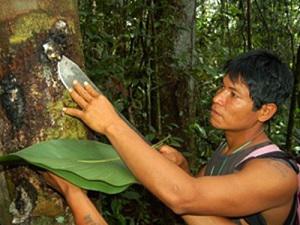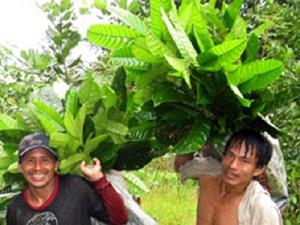Campbell Plowden
Other projects
30 Aug 2011
Sustainable Harvest and Marketing of Non-Timber Forest Products (NTFPs) with Indigenous Communities in the Northern Peruvian Amazon II
5 Sep 2014
Sustainable Harvest and Marketing of Non-Timber Forest Products (NTPFs) with Indigenous Communities in the Northern Peruvian Amazon III
Promote forest conservation in the northern Peruvian Amazon by supporting Bora and other native community efforts to sustainably harvest non-timber forest products and market high-value handicrafts and aromatic plant oils.

Amazon native harvesting copal resin.
This project will enhance forest conservation in the northern Peruvian Amazon by supporting the efforts of native communities near the biodiversity rich Ampiyacu-Apayacu Regional Conservation Area to sustainable harvest and market high-value non-timber forest products (NTFPs). Our project team will assist partner communities to develop local enterprises that tap the growing market for essential oils and fair-trade handicrafts.

Copal leaf collecting group.
Specific project goals are:
1) design sustainable systems to harvest aromatic plants and plants used to make handicrafts;
2) build local capacity to produce essential oils from aromatic plants;
3) create new handicrafts based on local plants and cultural traditions;
4) develop plans to market these value-added products as alternatives to economic activities that damage natural forests.
This pilot project will begin in the Bora community of Brillo Nuevo on the Yaguasyacu River where the Center has begun surveying copal trees that yield an aromatic resin and conducted trial resin distillations to produce essential oil. The Center has also begun working with its artisans to develop unique handicrafts such as palm fiber belts with the designs of jungle snakes. As we gain experience from this pilot phase, the project team will expand its activities to other Bora, Huitoto, and Ocaina villages in the region.
The project team will initially conduct surveys in different forest habitats to estimate the abundance of copal, other aromatic trees and wild plants used in making handicrafts. The next project tasks will be to measure the amount of useful product (resin, root, fruit, bark, leaves or fiber) that can be harvested from each plant, monitor harvest impact, and estimate when plants might be safely harvested again. Workshops will enable community members to learn skills for making essential oils and create innovative handicrafts based on local knowledge of plants, weaving, and culture. As new products are developed, the project team will work with the community and other partners to develop management plans to sustainable harvest key plants and marketing plans to sell these value-added NTFPs in Peru and beyond with mechanisms that fairly compensate harvesters, artisans and communities.
This project’s endpoint is not a collection of products; it is transformation. The collaborative process between the Center and native communities will build on and enhance traditional culture and ecological knowledge, encourage ongoing exploration of diverse forest resources, and mobilize creative energies to build sustainable communities. Communities will be considered incubators of respected artisans – not remote hamlets that need charity.